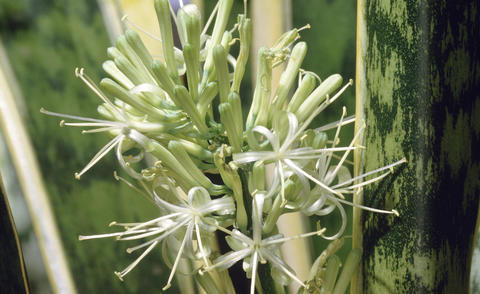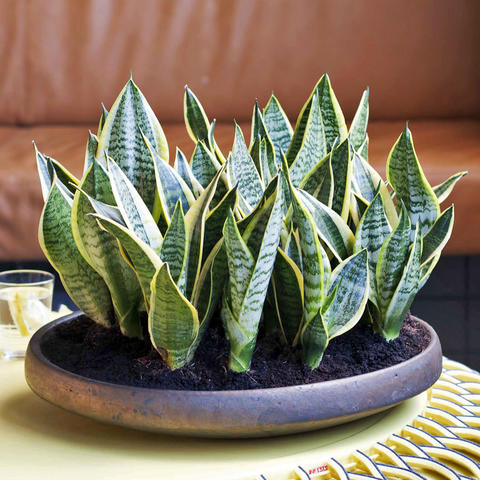Snake plant
The snake plant effortlessly thrives in many locations which are often problematic for other houseplants. Its heavily marked leaves also make this desert plant imposing and highly modern.
Factsheet
- Growth type
-
- rhizome
- Succulent
- Growth height (from)
- from 20 cm to 150 cm
- Growth width (from)
- from 20 cm to 50 cm
- Growth characteristics
-
- upright
- Flower color
-
- green
- white
- Flowering time (month)
-
- May to June
- Flower shape
-
- terminal
- multiflorous
- panicles
- Fragrance
-
- 2
- Leaf color
-
- green
- multicolored
- page format
-
- full margined
- long pointed
- sword-shaped
- Sheet properties
-
- evergreen
- Light
-
- sunny to semi-shade
- Soil Moisture
-
- moderately dry
- ph value
-
- neutral
- Lime compatibility
-
- lime-tolerant
- Nutrient requirements
-
- low in nutrients
- Humus
-
- low humus
- Decorative or utility value
-
- Leaf ornaments
- Toxicity
-
- weakly poisonous
- Winter Hardness
-
- frost-sensitive
- Use
-
- Interior greening
- Planters
- Winter garden
- Warm House
- Garden style
-
- Pot garden
The snake plant is also known as Sansevieria and belongs to the Asparagaceae family. The plant is closely related to dragon trees (Dracaena). Most of the 67 species of snake plant are at home in the warm, dry climate of tropical Africa. Some species also grow in the tropical parts of Asia. Gardening cultivation has now brought the snake plant to Florida, southern Europe and the Canary Islands. Some varieties of snake plant are cultivated as kitchen plants thanks to their hemp-like fibers. These are used as a raw material for rope-making and as bowstrings.
In 1794, the Swedish natural scientist Carl Peter Thunberg brought the plant to Europe and gave it the botanical name Sansevieria. Its namesake is Raimondo di Sangro, Count of San Severo, a well-known Italian scientist and inventor from the 18th century. Over time, the desert plant has adapted wonderfully to life indoors. The snake plant has been thriving as an exotic pot plant next to sunny windows for generations. Many breeds of the wild species of Sansevieria trifasciata have become very important as houseplants and office plants as they require very little care.
Sansevieria is a herbaceous succulent that does not form any upright plant stems. The basal leaves shoot out as small, fat rhizomes. They always end in a green, prickly point that also earned the plant the epithet “mother-in-law’s tongue”.

The around 70 varieties of snake plant that are used as houseplants at our latitudes have longer or shorter, strappy, fleshy leaves. Depending on the variety, they grow straight upright or are arranged as a rosette. The leaves of the various snake plant species and breeds are flat or rounded. They are marked on both sides with light or dark green cross bands and are up to 4.92 feet long. The succulent leaves of the snake plant are not only beautiful to look at, they also filter harmful substances (such as formaldehyde) out of the room air. Dried and ground or boiled leaves and rhizomes of certain snake plant species have an anti-inflammatory effect due to their leaf sap.
With good care, older Sansevieria sometimes display small, green-white, fragrant flowers. The special thing about these is: Snake plant flowers open at night. They are arranged similarly to panicles on a narrow shaft that reaches heights of up to two-thirds of the leaf length.
The tropical plants prefer a bright location next to large windows. Thanks to their robust nature, snake plants also thrive in sub-optimal location conditions. The ideal temperature is between 69.8 and 75.2 degrees Fahrenheit, however they can withstand room temperatures of up to 86 degrees Fahrenheit. Although during longer periods of high temperatures and lots of sun, Sansevieria should be given some shade. In the winter the room temperature should be a little lower, but never below 59 degrees Fahrenheit. Give the plants a brighter location during the winter months than in the summer and avoid drafts.

Tip: The snake plant adapts its color according to the lighting conditions. The darker the place where the plant is, the darker the color of the leaves. The leaves turn pale in very bright locations. In a bedroom the houseplant works like an oxygen generator. Unlike most plants, Sansevieria does not produce oxygen during the day, but at night. In this way, the snake plant ensures an excellent sleeping climate. However, you need more than one plant for a measurable positive effect.
As with all plants from the steppes and desert, Sansevieria prefer a substrate that is not too damp, permeable, and predominantly mineral-rich. A mixture of equal parts houseplant soil and clay granulate or coarse sand is ideal for snake plants. Ready-mixed succulent or cactus soil can also be used. Ensure there is good drainage when planting in pots in order to avoid waterlogging. Snake plants are also ideal for hydroponics.
When caring for Sansevieria, the motto is: Less is more! Snake plants prefer it too dry rather than too damp. This houseplant stores water in its leaves. So you should water Sansevieria sparingly and leave the soil to dry out before watering again. Sansevieria that stand in the wet for a long period of time are at risk from rot. Do not water the leaf rosettes directly, rather water to the side on the soil or into a plant pot saucer. The snake plant does tolerate tap water with lime, but it prefers lime-deficient tap water. You should only water snake plants every four weeks in the winter. At temperatures below 50 degrees Fahrenheit you should stop watering completely as this is when the Sansevieria takes a rest from growing.
Give the Sansevieria cactus fertilizer or a standard trade green plant fertilizer every three to four weeks from March to October. Ideally, you should add a liquid fertilizer to the plant’s water. It is better to give snake plants too little fertilizer rather than too much. Do not fertilize snake plants in the winter.
Flat pots with wide diameters are ideal for Sansevieria, as the plants develop thick rhizomes that spread horizontally just under the surface of the soil. Repot the plants as necessary in March or April. This is only necessary when the plants are completely rooted through, if the rhizomes push one another up out of the soil or grow over the rim of the pot. Some leaves may topple away over the sides on tall houseplants as the rhizome is not sufficiently anchored in the soil. This is also a sign that the time has come to repot your snake plant.

Before repotting the snake plant, place a layer of clay fragments over the holes in the pot. Fill a thin layer of clay granulate at the very bottom for drainage. You only need to change the top soil layer each year for larger plant containers. As the thin-growing, tall snake plant species can become top-heavy, you should place them in heavy pots or planters. Pot the snake plant at the same height as it stood previously.
Snake plants do not usually require pruning. However, you can cut off individual leaves which are bothersome at any time as a maintenance measure with a sharp knife, directly on the rhizome.
In addition to the basic green types, there are also beautiful, colorfully patterned snake plant variants.
- The varieties are differentiated according to color (green, silver or golden) or leaf length within the Sansevieria trifasciata species.
- Probably the best-known snake plant variety is Sansevieria ‘Laurentii’. Its leaves are lined with long, golden- stripes.
- Sansevieria ‘Silver Cloud’ has silver-patterned leaves
- ‘Hahnii’ types are low-growing and rosette-shaped.
- Round, extremely long and upright growing leaves are indicative of the cylindrical snake plant (Sansevieria cylindrica). They are available in lots of sizes. Their green or gray leaves are also laced.
- The star sansivieria (Sansevieria kirkii) has lots of tiny, thin leaves. There are also several decorative types of this species.
- One particularly pretty variant of the easy-care house plant is the fan snake plant (Sansevieria zeylanica).

The green-leaved snake plant can be very easily propagated in the spring or summer through cuttings roughly 1.97 inches long, taken from the leave segments of young plants. However, you should note when propagating the snake plant which cut edge belongs at the top and which at the bottom! The cut surfaces should be left to dry in the air for about a week after cutting. Only then should the leafed pieces be planted in damp substrate. They quickly form small, rooted rhizomes in the semi-shade at 69.8 degrees Fahrenheit, from which new leaves shoot out. They can then be planted individually in pots. However, be aware that yellow-striped varieties of snake plant cuttings lose their typical coloring when propagated in this way and only produce green leaves.
Colorful leaf varieties can be readily propagated through division. For slim, upright growing species, separate rooted rhizome pieces with a few leaves from the mother plant. It is best to take these children and plant them at the same time as repotting. Shorten the leaves of long-leafed varieties by about half so that the plant is stable in the pot. With rosette-shaped growing Sansevieria, the individual rosettes are carefully separated from one another so that each one has a few roots. The pieces are planted individually in flower pots.
The snake plant is a very robust plant even with moderate care and in sub-optimal conditions; it even forgives major care errors. Pests and plant diseases are also quite rare with this houseplant. Brown colored or limp leaves are generally caused by root rot, waterlogging or temperatures that are too low. The most frequent pests on snake plants are mealybugs. The plants are also occasionally infested with spider mites when they are in dry, heated air.

